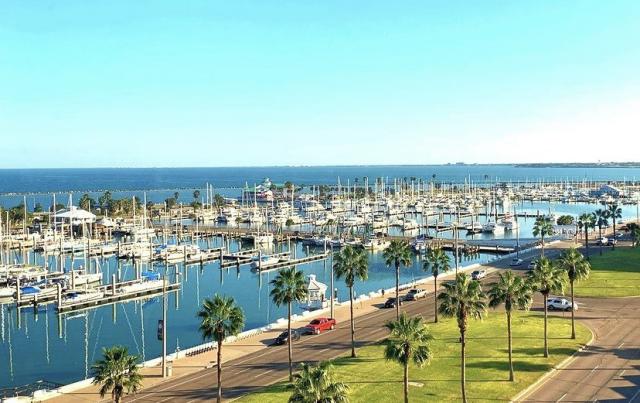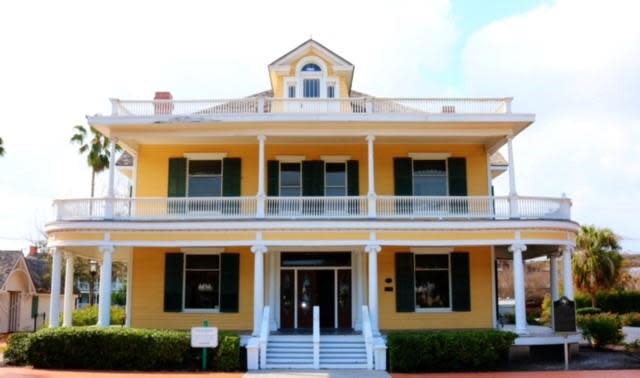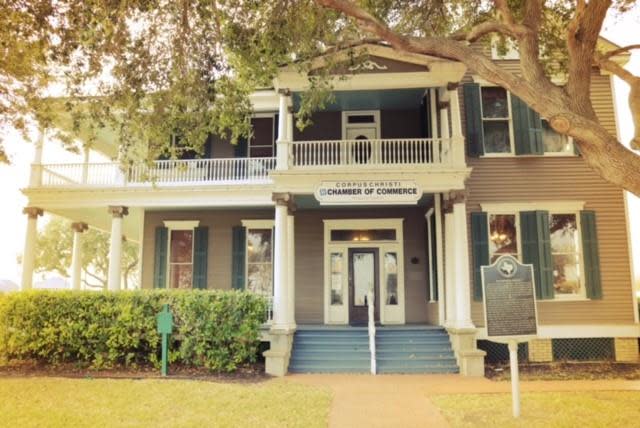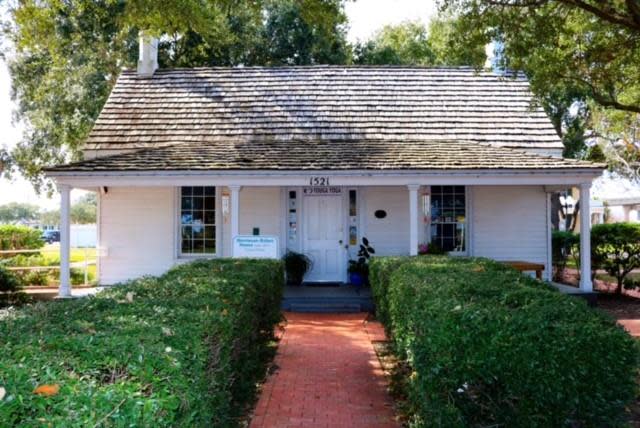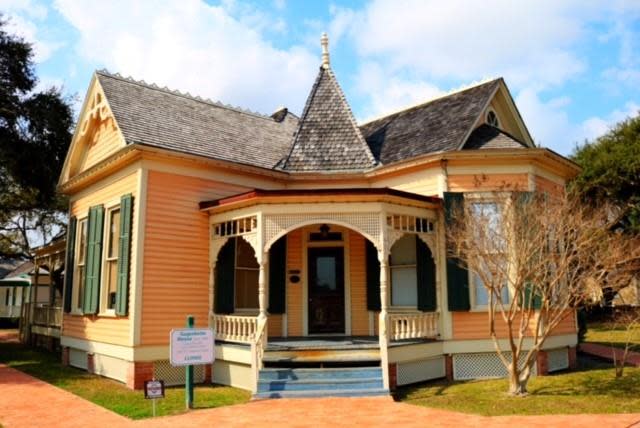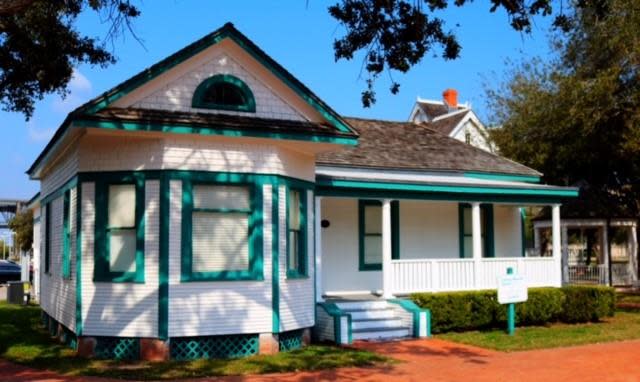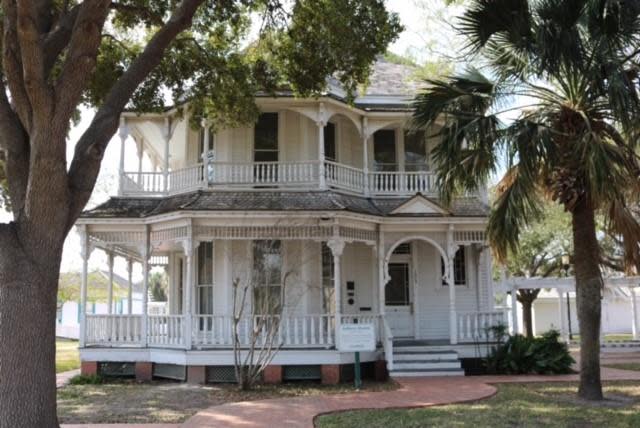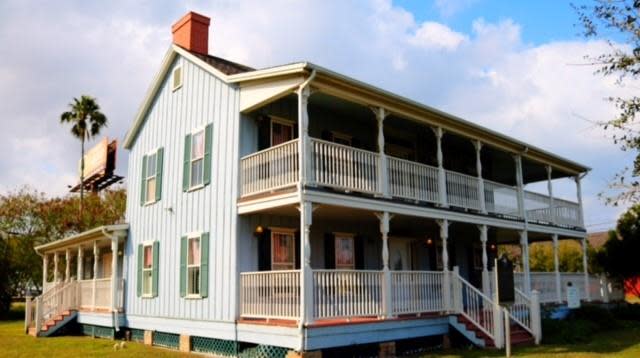Corpus Christi Heritage Park is a collection of 12 historic homes. Each home is rich in architecture, history and culture but more importantly, each of the homes tell a story of the early residents of this community. Take a look at the historic markers in front of each home and use this walking tour as a guide to learn the story behind Corpus Christi’s heritage.
1. The French-Galvan House in the center of Heritage Park was home to Rafael Galvan who was a founding member of the League of United Latin American Citizens (LULAC).
Originally built in 1908 by A.M. French, the Galvan family purchased the home in 1942 and it remained in the family until 1982. Rafael Galvan was the first Mexican-American police officer in Corpus Christi and also established the Galvan Ballroom which was THE hot spot for Corpus Christi's dancing scene!
The French-Galvan House is currently home to the Corpus Christi Parks and Recreation Department and hosts numerous weddings, parties and events throughout the year. While there is no official tour provided, visitors are welcome to casually tour the premises. This is a functioning business office, so please remember to be respectful while touring!
2. The Grande-Grossman House (to the left of the French-Galvan House) was home to Benito (Ben) Grande. The Grande men owned the Ben Grande Saloon, one of the largest and last old-fashioned cantinas in Texas.
Originally built in 1904 by Ben Grande, Ida Grossman Cohen purchased the home in 1925 and later donated it to the City of Corpus Christi in 1982. The Grossman family (including Ed, Henry, Simon, and Ida) founded Grossman Brothers Department Store with 20 feet of space, and eventually owned one of the largest businesses in Corpus Christi with seven locations. Ed was one of the founders of Temple Beth El.
The Grande-Grossman House is currently home to the Tejano Civil Rights Museum and Resource Center which features six rooms filled with artifacts, including historic maps, photos and art. Each month the museum features a collection from a Hispanic artist. The Tejano Civil Rights Museum and Resource Center is open to the public with free admission on weekends. Hours are Saturday 9:00 a.m.-5:00 p.m., and Sunday 1:00-6:00 p.m.
3. The Ward-McCampbell House (behind the Grande-Grossman House, on the corner of Fitzgerald St. and N. Chaparral St.) is rumored to be haunted by the original owner, Mary Alice Ward McCampbell, who died of pneumonia after standing on the second floor balcony during the Hurricane of 1919 and watched the flood waters rise over 20 feet to her second story porch.
If you walk one block toward Corpus Christi Bay, stop at the corner of Water St. and Fitzgerald St. and you'll stand in the very spot of this home's original location. At the time that this home was built, in 1908, all of the land between Water St. and Corpus Christi Bay was under water. In 1941, the City of Corpus Christi completed the seawall which now protects downtown from flood tides.
The Ward-McCampbell House is currently home to Visit Corpus Christi.
4. The Jalufka-Govatos House (to the right of the Ward-McCampbell House) was built by James Jalufka, the son of a Moravian (Czech) immigrant in what is known as "Old Irishtown."
Originally built in 1905 by James and Helen "Captain" Jalufka (pronounced Jah-Luf-Kuh). Helen earned the nickname "Captain" when she successfully operated a boat works at the old Pleasure Pier in downtown Corpus Christi. In 1944, Pete and Minnie Lee Govatos (pronounced Go-Vuh-Tahs) purchased the home. Pete Govatos was the Vice President of the first Parish Council of the St. Nicholas Greek Orthodox Church in 1948.
5. The Merriman-Bobys House (to the right of the Jalufka-Govatos House) was home to Anna and Walter Merriman, whose nephews both fought in the Civil War - one brother fought for the Confederate forces and the other fought for the Union!
Originally built in 1851, by Walter Merriman, this house is the second oldest structure existing in Corpus Christi. The oldest is the Centennial House, still in the original location at 411 Upper Broadway. This home was built one year before the City of Corpus Christi was officially incorporated in 1852.
6. The Gugenheim House (to the right of the Merriman-Bobys House) is one of the few Victorian homes that survived the Hurricane of 1919 in Corpus Christi.
The Hurricane of 1919 was one of the strongest storms of the 20th century with winds reaching 110 mph and wave heights greater than 16 feet If you want to imagine what the view was like from this home, visit 1101 N. Chaparral St. and look toward Corpus Christi Bay.
While there is no official tour provided, visitors are welcome to casually tour the exterior of the premises.
7. The Littles-Martin House (to the left of the Gugenheim House) was given to the Littles family by their employers, John G. and Marie Stella Kenedy. Hattie Moore and Willis Littles were believed to be the first black natives and first black Catholics of Corpus Christi.
The original site of the Littles-Martin house is unknown, as it was moved to N. Staples St. around 1918. Mary Belle Littles-Martin, daughter of Hattie Moore and Willis, attended Incarnate Word Academy where she studied piano in secret, so as not to be noticed. Mary Belle taught piano from this very home for many years until her death in 1983.
The Littles-Martin House is currently home to the Corpus Christi headquarters of the National Association of Advancement of Colored People (NAACP). While there is no official tour provided, visitors are welcome to casually tour the premises. This is a functioning business office, so please remember to be respectful while touring!
8. The Sidbury House (to the right of the Littles-Martin House) was built in 1893, as a rental property by one of the most well regarded civic leaders in Corpus Christi, Mrs. Charlotte Cook Scott Sidbury. Throughout the early 1900s, Mrs. Sidbury was a rancher, a bank director and a lumber manager.
Though Mrs. Sidbury's contributions to Corpus Christi are impressive, those contributions of her tenant, Patrick Dunn, are almost equally profound. Mr. Dunn leased a small part of Padre Island in the late 1800s for a cattle operation and by 1926 owned almost all of the Island. The Dunn Ranch cattle operation ended in 1971 after the establishment of the Padre Island National Seashore, where traces of the line camps still remain today.
The Sidbury House is currently home to the Corpus Christi Parks and Recreation Department. While there is no official tour provided, visitors are welcome to casually tour the premises. This is a functioning business office, so please remember to be respectful while touring!
9. The Julius Lichtenstein House (to the right of the Sidbury House) was originally built on the site of The Ritz Theater, which still stands in downtown Corpus Christi, and was one of the first homes moved to Heritage Park in 1929.
In 1874, Mortiz Lichtenstein, father of Julius Lichtenstein, opened Lichtenstein's Department Store, which was a staple of retail shopping in downtown Corpus Christi for over 100 years. Unfortunately the original Lichtenstein's building is no longer standing, but the Cosmopolitan Lofts were built in the same location with architecture emulating the original.
The Julius Lichtenstein House is currently home to the Instituto De Cultura De Hispanica which provides visitors with a better understanding of the diverse cultures represented in our community through programs such as art exhibits, folkloric displays, English and Spanish recitals, cultural celebrations and theatrical performances. Hours are Tuesday-Saturday 10:00 a.m. – 2:00 p.m.
10. The Lawrence House (behind Heritage Park on Mesquite St.) was the home of Theodore Merchant Buddy Lawrence, who was credited with sending the first shipment of vegetables from Corpus Christi - 10 cases of peas - to San Antonio.
Theodore Lawrence moved to Corpus Christi (from England) with his father in 1840. As a physician, Dr. David Lawrence believed that moving to the warm and sunny climate of Texas would improve the health of his young son. In 1867, despite his father's efforts to save him, Theodore Lawrence died in a yellow fever epidemic which killed approximately one third of the population.
The Lawrence House is currently home to the Veterans Band of Corpus Christi. While there is no official tour provided, visitors are welcome to casually tour the premises. This is a functioning business office, so please remember to be respectful while touring!
11. The Steamboat House (to the right of the Lawrence House) was built in 1890 by Capt. W. T. Ropes, whose brother; Col. Elihu Harrison Ropes originally purchased Mustang Island for $25,000. Port Aransas was originally called Ropesville because of Col. Ropes' community contributions.
Originally located on Ocean Drive near present day Ropes Park, the Steamboat House was moved in 1920 to 802 Carancahua St. and divided into apartments. Not until 2007, would this home be recognized as the twelfth addition to Heritage Park.
While there is no official tour provided, visitors are welcome to casually tour the exterior of the premises.
12. The Britton-Evans Centennial House (a short drive into uptown Corpus Christi) is the oldest building in Corpus Christi.
While considered a part of Heritage Park, this home only a short drive away as it is still located on the original home site at 411 N. Upper Broadway. Built between 1849 and 1850 by Capt. Forbes Britton, this home played a significant role in public safety during the Hurricane of 1919 because of its solid "shellcrete" construction and strategic location, high above floodwaters.
The Britton-Evans Centennial House is currently home to the Corpus Christi Heritage Society which provides visitors an opportunity to tour the interior complete with authentic antique furnishings of the period. Hours are 12 p.m. - 4 p.m. on the first Sunday of every month.

